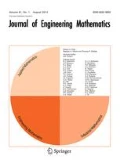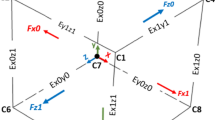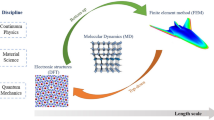Abstract
Material flow simulation is in increasing need of multi-scale models. On the one hand, macroscopic flow models are used for large-scale simulations with a large number of parts. On the other hand, microscopic models are needed to describe the details of the production process. In this paper, we present a hierarchy of models for material flow problems ranging from detailed microscopic, discrete element method type, models to macroscopic models using scalar conservation laws with non-local interaction terms. Numerical simulations are presented at all levels of the hierarchy, and the results are compared to each other for several test cases.











Similar content being viewed by others
References
Hoher S, Schindler P, Göttlich S, Schleper V, Röck S (2011) System dynamic models and real-time simulation of complex material flow systems. In: ElMaraghy HA (ed) Enabling manufacturing competitiveness and economic sustainability 2012, Part 3, pp 316–321
Jahangirian M, Eldabi T, Naseer A, Stergioulas LK, Young T (2012) Simulation in manufacturing and business: a review. Eur J Oper Res 203:1–13
Reinhart G, Lacour F (2009) Physically based virtual commissioning of material flow intensive manufacturing plants. In: Zaeh MF, ElMaraghy HA (eds) 3rd international conference on Changeable, Agile, Reconfigurable and Virtual production (CARV 2009), pp 377–387
Cleary PW, Sawley ML (2002) DEM modeling of industrial granular flows: 3D case studies and the effect of particle shape on hopper discharge. Appl Math Model 26:89–111
Cundall PA, Strack ODL (1979) A discrete numerical model for granular assemblies. Geotechnique 29:47–65
Lätzel M, Luding S, Hermann HJ (2000) Macroscopic material properties from quasi-static, microscopic simulations of a two-dimensional shear-cell. Granular Matter 2:123–135
Campbell CS (1990) Rapid granular flows. Annu Rev Fluid Mech 22:57–92
Göttlich S, Hoher S, Schindler P, Schleper V, Verl A (2014) Modeling, simulation and validation of material flow on conveyor belt. Appl Math Model 38:3295–3313
Lun CKK, Savage SB, Jeffrey DJ, Chepurniy N (1984) Kinetic theories for granular flow: inelastic particles in Couette flow and slightly inelastic particles in a general flowfield. J Fluid Mech 140:223–256
Carrillo JA, D’Orsogna MR, Panferov V (2009) Double milling in self-propelled swarms from kinetic theory. Kinet. Relat. Models 2:363–378
Etikyala R, Göttlich S, Klar A, Tiwari S (2014) Particle methods for pedestrian flow models: from microscopic to non-local continuum models. Math Models Methods Appl Sci 24:2503–2523
Colombo R, Garavello M, Lecureux-Mercier M (2012) A class of non-local models for pedestrian traffic. Math Models Methods Appl Sci 22:1150023
Babic M (1997) Average balance equations for granular materials. Int J Eng Sci 35:523–548
Zhu HP, Yu AB (2002) Averaging method of granular materials. Phys Rev E 66:021302
Zhu HP, Yu AB (2005) Micromechanic modeling and analysis of unsteady-state granular flow in a cylindrical hopper. J Eng Math 52:307–320
Braun W, Hepp K (1977) The Vlasov dynamics and its fluctuations in the 1/N limit of interacting classical particles. Commun Math Phys 56:101–113
Neunzert H (1977) The Vlasov equation as a limit of Hamiltonian classical mechanical systems of interacting particles. Trans Fluid Dyn 18:663–678
Cañizo JA, Carrillo JA, Rosado J (2011) A well-posedness theory in measures for some kinetic models of collective motion. Math Models Methods Appl Sci 21:515–539
Chuang YL, D’Orsogna MR, Marthaler D, Bertozzi AL, Chayes L (2007) State transitions and the continuum limit for a 2D interacting, self-propelled particle system. Phys D 232:33–47
Topaz CM, Bertozzi AL (2004) Swarming patterns in a two-dimensional kinematic model for biological groups. SIAM J Appl Math 65:152–174
Huang F, Marcati P, Pan R (2005) Convergence to the Barenblatt solution for the compressible Euler equations with damping and vacuum. Arch Ration Mech Anal 176:1–24
Tiwari S, Kuhnert J (2007) Modelling of two-phase flow with surface tension by finite point-set method (FPM). J Comp Appl Math 203:376–386
Klar A, Tiwari S (2014) A multi-scale meshfree particle method for macroscopic mean field interacting particle models. Multiscale Model Simul 12:11671192
Degond P, Mustieles FJ (1990) Approximation of diffusion equations by deterministic convections of particles. SIAM J Sci Stat Comput 11(2):293–310
Aronson DG (1969) Regularity properties of flows through porous media. SIAM J Appl Math 17:461–467
Acknowledgments
This work was supported by the German research foundation, DFG grants KL 1105/20-1, GO 1920/3-1 and the BMBF Project KinOpt.
Author information
Authors and Affiliations
Corresponding author
Rights and permissions
About this article
Cite this article
Göttlich, S., Klar, A. & Tiwari, S. Complex material flow problems: a multi-scale model hierarchy and particle methods. J Eng Math 92, 15–29 (2015). https://doi.org/10.1007/s10665-014-9767-5
Received:
Accepted:
Published:
Issue Date:
DOI: https://doi.org/10.1007/s10665-014-9767-5




